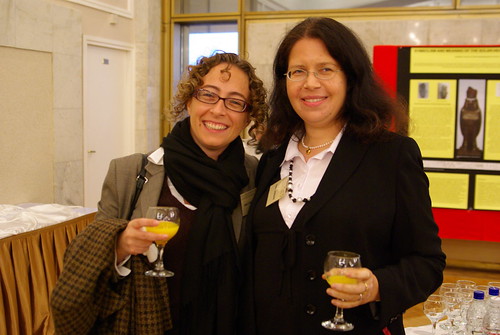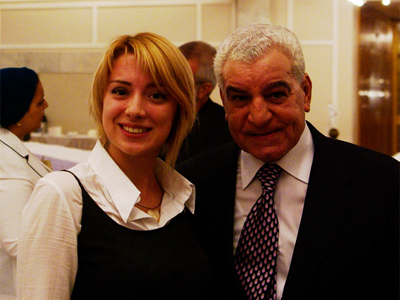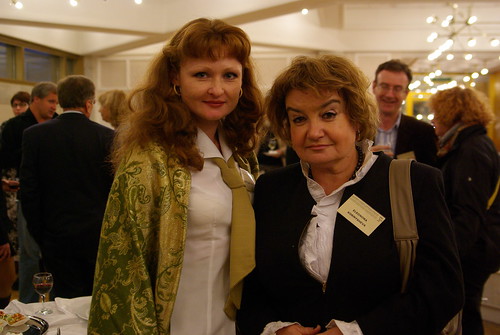 The first day of the ‘Achievements and Problems of Modern Egyptology‘ conference was full of new discoveries, though it started on a typically soggy Moscow day. After participants arrived at the Presidium of Russian Academy of Sciences on comfortable buses, they went in and received a slightly altered conference program – containing lecture lists and ‘Return to Egypt’; a book about the history of Russian Egyptology. The conference started with an opening speech by vise-president of Russian Academy of Sciences Alexander D. Nekipelov, dedicated to the history, development and achievements of Russian archaeology in Egypt, from the research of Vladimir Golenischev to today. The ceremony continued with speeches by a representative from the Ministry of Culture and, of course, Dr. Zahi Hawass.
The first day of the ‘Achievements and Problems of Modern Egyptology‘ conference was full of new discoveries, though it started on a typically soggy Moscow day. After participants arrived at the Presidium of Russian Academy of Sciences on comfortable buses, they went in and received a slightly altered conference program – containing lecture lists and ‘Return to Egypt’; a book about the history of Russian Egyptology. The conference started with an opening speech by vise-president of Russian Academy of Sciences Alexander D. Nekipelov, dedicated to the history, development and achievements of Russian archaeology in Egypt, from the research of Vladimir Golenischev to today. The ceremony continued with speeches by a representative from the Ministry of Culture and, of course, Dr. Zahi Hawass.
The opening speech and lecture by Dr. Hawass focused on recent discoveries and the preservation of Egyptian heritage. Many new museums are created in Egypt, but heritage sites are protected from animals (the highly debated decision of closing Giza pyramids to horses and camels) – and maybe someday from tourists (by creating a replica of King Tut’s tomb and new route to the Valley of the Kings).
Opening Lecture by The-Man-With-The-Hat
Dr. Hawass promised to publish the results of DNA studies of Tutankhamun’s family within a few months, after the results of Egyptian team’s research is confirmed by independent experts. He also shared a facinating story about scanning King Tut’s mummy: The first time it was put in the scanner, the machine stopped and didn’t work for over an hour. He admits this was the first – and only – moment he ever believed in the so-called ‘curse of the mummy‘.
Even more fascinating was a story about queen Hatshepsut; we’re talking real Mummy CSI here. Just imagine identifying a mummy of the queen by a mere lost tooth, stored in a special box in the tomb. Further research on Hatshepsut’s mummy shows cancer as the cause of death, and that for some reason the queen’s remains were moved from her tomb to KV60 where they were eventually discovered.
In the last part of his speech Dr. Hawass focused on excavations of of the tunnel of Seti I and further research, and the quest for KV64 in the Valley of the Kings. The search for KV64 has yielded no result thus far, except for the discovery of many osctracons, remains of workmen’s huts, storage rooms, and channels to redirect flooding. Dr. Hawass also mentioned that four intact tombs were found in the Valley of the Nobles.
After a welcome coffee break, we listened to a lecture by Dr. Galina Belova on research and excavations at Kom Tuman, Memphis. Soil investigations have made it clear that the Nile in the past flowed near to the excavated area, making Tom Tuman one of the ‘islands of Memphis.’
The Power of the Image: Propaganda for Pharaohs
The second presentation on day one of the conference was Diana Liesegang with ‘The Power of the Image’: an extremely interesting investigation on how ancient Egyptian images influenced the empire’s peasant populace; it cannot be denied that the images – and the combination of image and text – were extensively used as a form of royal propaganda. The Pharaoh was displayed as conqueror; a victorious person blessed by the gods and smashing his enemies. Ancient artists combined inscriptions and graphical elements for symbolic representation – the Pharaoh was sometimes shown as a lion, a crocodile or a hawk – and the layout created a powerful impression to deliver its clear message. This heavy use of iconography developed from the Predynastic period to the Ramesside period. But afterwards its use was almost entirely abandoned.
 Ann Macy Roth from New York University presented an investigation into the Old Kingdom cemeteries and settlements next, looking at the ‘cities of the dead‘ during their construction process, and afterwards as sites of human activity rather than simply a necropolis.
Ann Macy Roth from New York University presented an investigation into the Old Kingdom cemeteries and settlements next, looking at the ‘cities of the dead‘ during their construction process, and afterwards as sites of human activity rather than simply a necropolis.
Biblical Figures Guest-starring in Egyptian Religion
Kerry Muhlenstein presented that it’s not just the Jewish religion that adopted some aspects of Egyptian religion in the Bible, but that Egyptians themselves borrowed biblical personalities and stories. The most popular ones are JAO (Jegova), Sabbaoth, Adonai, Michael, Abraham and Moses, and the names of these biblical figures appear on stelae and the so-called ‘magical papyri’; both elements of religous practice in Ancient Egypt.
Why were these stories and personalities adopted by the Egyptians? Because ancient Egyptian religion was highly flexible, and was influenced by many other religions. The biblical stories are faint and deal with clear plots – revelation, the summoning of gods and their subsequent arrival – making them clear and easy to grasp for the ordinary people. This even led to occurrences of Abraham replacing Osiris in certain fragments. The influence of biblical stories was the strongest during the Ptolemaic period: the characters are popularized in Greek literature, one Jewish person even writes a letter to Ptolemy II, telling him there is a God who created the entire world and protects not only Jews but the Pharaoh.
Representing the Chinese University of Hong King, Mu-chou Poo showed the interesting parallels between Ancient Egyptian and Chinese wisdom in literature. ‘Wisdom literature’ has been regarded as one of the keys for unlocking more information on social ethics of the ancient Egyptians, offering notions of social values by practical examples like how to treat one’s neighbours, family or superiors.
The Russian Mission at Giza
After lunch, the day of discoveries continued with lectures by Irene Fostner-Mueller and Erhart Graefe about excavations at Avaris and TT (Theban Tomb) 320 respectively. ThenDr. Eleonora Kormysheva gave a very interesting and detailed presentation on the Russian Archaeology Mission at Giza, which combines geophysical studies carried out before the excavation, GPR research and soil and rock examination.
The Russian mission has been working at Giza since 1996. The excavations and research have been concentrated on the rock-cut tomb of Khafraankh, the chief of the wab-priests of the Pyramid of Khafra and then on the Minor Cemetery beside this tomb. The mission re-excavated two tombs mentioned by Karl Richard Lepsius and O. Mariette: the tombs of Thenti II and Khufuhotep. One tomb – that of Thenti I – was not known before. The tombs are dated to the end of the Fifth Dynasty. Three new rock-cut tombs (of Perinedju, Perseneb and Ibi) are in the initial stage of excavation. Dr. Kormysheva kindly promised to provide Heritage Key with additional information about the Russian mission in Giza.
Then followed lectures by Laura Pantalacci, about work in Qift-Coptos and Cornelius von Pilgrim, and Wolfgang Mueller about excavating the different layers of Aswan and finding a great fortification construction that guarded Aswan, and its banks that was joined with the Elefantina fortress.
After a very nice and warm welcome reception, where everyone could chat and get refreshments and snacks, the participants went to the Moscow city tour and ultimately their hotels, where they could reflect on a day’s work well done.


